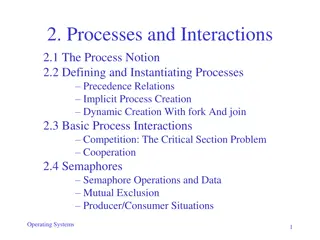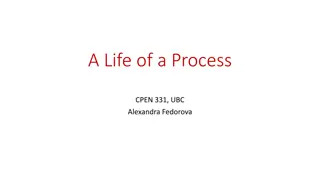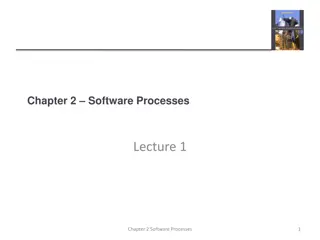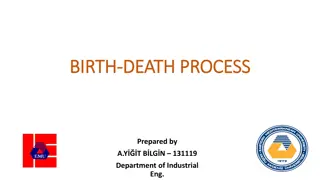
Processes in Operating Systems
Explore the concept of processes in operating systems, including creation, switching, and destruction. Learn about process descriptors and how processes communicate with the operating system. Dive into the key components of task_struct for managing process-related information efficiently.
Download Presentation

Please find below an Image/Link to download the presentation.
The content on the website is provided AS IS for your information and personal use only. It may not be sold, licensed, or shared on other websites without obtaining consent from the author. If you encounter any issues during the download, it is possible that the publisher has removed the file from their server.
You are allowed to download the files provided on this website for personal or commercial use, subject to the condition that they are used lawfully. All files are the property of their respective owners.
The content on the website is provided AS IS for your information and personal use only. It may not be sold, licensed, or shared on other websites without obtaining consent from the author.
E N D
Presentation Transcript
Chapter 3: Processes Smruti R Sarangi IIT Delhi (c) Smruti R. Sarangi, 2023 1
Outline of this Chapter Process Switching Creation & Destruction Process Descriptor Concept (c) Smruti R. Sarangi, 2023 2
Introduction to a Process What is a process? It is an instance of a running program. When we run a program, it acquires a life of its own and is associated with a lot of additional data structures. All of these including the state of the executing program comprise the process. What does a process own? CPU time, memory, open files, network connections, How do processes communicate with the OS? Processes send messages to the OS via system calls. The OS sends messages to a process via signals (exact mechanism described later) (c) Smruti R. Sarangi, 2023 3
Organized as a tree. Types of Processes Stand-alone or as a lightweight process in a group A group of lightweight processes (threads) share part of the address space between themselves. Single-threaded Contains only a single thread of execution Multi-threaded Contains multiple threads of execution (c) Smruti R. Sarangi, 2023 4
Outline of this Chapter Process Switching Creation & Destruction Process Descriptor Concept (c) Smruti R. Sarangi, 2023 5
The Process Descriptor include/linux/sched.h struct task_struct This is the apex data structure for storing all process-related information. Every process is associated with a task_struct data structure It maintains all the bookkeeping information for the process It is quite complex Reason: The main aim is to keep all process-related information in one place. (c) Smruti R. Sarangi, 2023 6
The Key Components of task_struct Field Meaning struct thread_info thread_info Low-level information uint state Process state void * stack Kernel stack Priorities prio, static_prio, normal_prio struct sched_info sched_info Scheduling information struct mm_struct *mm, *active_mm Pointer to memory information pid_t pid Process id struct task_struct *parent Parent process struct list_head children, sibling Child and sibling processes File system, I/O, synchronization, and debugging fields (c) Smruti R. Sarangi, 2023 7
The core of task_struct used to be thread_info What is thread_info? It is a low-level data structure to store task-related information. What is a low-level data structure? Its layout is machine specific. Typically, its position in the address space and the way its fields are laid out are found to be very useful in accessing it to retrieve useful information. The contents of the data structure also abstract out details of the underlying hardware. (c) Smruti R. Sarangi, 2023 8
thread_info arch/x86/include/asm/thread_info.h struct thread_info Contains some important information about the HW state struct thread_info { unsigned long flags; unsigned long syscall_work; u32 status; u32 cpu; } Flags for the state of the process, system calls, and thread synchrony, resp. Current CPU (c) Smruti R. Sarangi, 2023 9
The Process State TASK_ZOMBIE (task finishes or is terminated) Execution finished New task created Scheduler asks it to execute TASK_RUNNING (ready but not running) TASK_RUNNING (currently running) TASK_STOPPED (stopped) SIGSTOP Preempted for some reason Woken up (by the 0S) SIGCONT TASK_INTERRUPTIBLE or TASK_UNINTERRUPTIBLE Go to sleep 10 (c) Smruti R. Sarangi, 2023
Explanation of the Process States We have two running states Can run (not getting an available CPU) Already running There are two interrupted states INTERRUPTIBLE The process can be sent a message from the OS (known as a signal), and it can be woken up UNINTERRUPTIBLE The process is waiting for a particular resource to become available. It will not wake up regardless of the signal that is sent to it. TASK_ZOMBIE A process finishes if the OS kills it or if it calls the exit() system call Its state is however not removed. Its parent is informed with the SIGCHLD signal. The parent needs to call the system call wait() to read the exit value of the child and then only the child process s state is cleaned up. (c) Smruti R. Sarangi, 2023 11
More about Process States ZOMBIE state continued The process needs to explicitly call exit(int exitcode) when it finishes exitcode indicates the status of the process s execution If it is 0, then it means that the process executed successfully Otherwise, it means that there was an error. The exit code indicates the type of the error A value of `1 indicates that there was an error (not specific) Any other value indicates the exact nature of the error Processes are organized in a tree-like hierarchy. Every process has a parent. The parent needs to know the status of the child s execution (exit code). Hence, we maintain the child process as a zombie until the parent reads its status using variants of the wait system call. (c) Smruti R. Sarangi, 2023 12
The STOPPED state A process can be stopped/suspended Send it the SIGSTOP signal: example, kill STOP {process id} The kill system call or command line command kill sends a signal to a process This suspends the process Another approach: Type Ctrl-Z on the terminal Sends the SIGTSTP signal A process can choose to ignore this If it is not ignored, the process is suspended The process can be resumed by sending the SIGCONT signal to it Use a system call to send the signal to a process Use the fg command line utility (c) Smruti R. Sarangi, 2023 13
The Kernel Stack Where does a process keep its information when there is a context switch? Does it need an avatar that runs in kernel mode? Every process is associated with a kernel stack and often a kernel thread. When a kernel thread works on behalf of the process to do some work for it, the kernel stack is used. There are some limitations on the kernel stack. It cannot be arbitrarily large. In fact, no structure in the kernel can grow indefinitely and irregularly. Memory management of kernel pages is complicated. (c) Smruti R. Sarangi, 2023 14
Limitations on the Kernel Stack Its size is limited to 4 KB * 2 = 8 KB They contain useful data as long as the thread is alive or in a zombie state There are per-thread stacks and a few stacks that are reserved for each CPU The main CPU stack is an interrupt stack that is used by interrupt handlers What about nested interrupts? Some interrupts are non-maskable interrupts (NMIs) They cannot be ignored. This means that if we are already running an interrupt handler, then we need to still handle these interrupts. There is thus a need to switch to a new interrupt stack (for the NMI) x86 processors have an interrupt stack table (IST) per CPU with 7 entries (c) Smruti R. Sarangi, 2023 15
Structure of the Stack in Old Kernels Problem: Given the stack pointer, find the address of the bottom of the stack (assume it is aligned to an 8 KB boundary)? Stack current = esp & ~(1 << 13 1) 8192 = 213 Pointer to thread_info task_struct thread_info current It was at the bottom of the stack It was easy for code to find the address of the task_struct via the thread_info structure 16 (c) Smruti R. Sarangi, 2023
Can we reduce 2 instructions to just 1? This requires two instructions: 1. AND insruction 2. Load instruction Just 1 inst.? (c) Smruti R. Sarangi, 2023 17
Fast and efficient In the Current Kernel The current macro DECLARE_PER_CPU(struct task_struct *, current_task); static __always_inline struct task_struct *get_current(void) { return this_cpu_read_stable(current_task); } #define current get_current() Store the pointer to the current task in a global variable. The this_cpu_read_stable macro reads the task_struct pointer from a separate per-CPU memory region (accessed using the gs segment register). In some architectures, this points to a thread_info structure that in turn has a pointer to the task_struct (c) Smruti R. Sarangi, 2023 18
What did we learn from this part? The current task_struct is something that needs to be accessed very quickly and very frequently Where do we store it? We cannot store it in a general-purpose register. We have limited registers. We cannot store it in a global variable. Should be CPU-specific. We can store a pointer to it at the bottom of the stack. We would need additional instructions to compute the address of the pointer. Store a pointer to it in a model-specific register (MSR) A pointer can be stored in the local storage area on the CPU, whose address is known (used in x86) (c) Smruti R. Sarangi, 2023 19
What is actually used? https://docs.kernel.org/core-api/this_cpu_ops.html We store per-CPU variables in segmented memory The gs segment register points to a per-CPU memory region Store all CPU-local variables there The DEFINE_PER_CPU macro in the kernel does exactly this The cache lines are not shared between processors Leads to a higher performance (lines don t bounce between cores) gs (c) Smruti R. Sarangi, 2023 20
Field Meaning struct thread_info thread_info Low-level information uint state Process state void * stack Kernel stack Priorities prio, static_prio, normal_prio struct sched_info sched_info Scheduling information struct mm_struct *mm, *active_mm Pointer to memory information pid_t pid Process id struct task_struct *parent Parent process struct list_head children, sibling Child and sibling processes File system, I/O, synchronization, and debugging fields (c) Smruti R. Sarangi, 2023 21
Process Priorities Different processes have different priorities. This information is used by the scheduler for scheduling. Priority range 0 139 Processes with mission critical requirements 0 99 Real time process priorities 100 139 This is for user processes User process priorities (c) Smruti R. Sarangi, 2023 22
How do we interpret the process priorities? The sense of normal and real-time priorities is different For real-time processes, higher the priority value, higher is the actual priority For regular processes, lower the priority value, higher is the actual priority This means that a task with priority 139 has the lowest priority in the system This means that a task with priority 99 has the highest priority in the system The nice mechanism A user process can change its user priority by invoking the <nice> or <chrt> commands > nice n <nice value> <command> Priority = 120 + <nice value> (c) Smruti R. Sarangi, 2023 23
Relevant Kernel Code kernel/sched/core.c else if (rt_policy(policy)) prio = MAX_RT_PRIO - 1 - rt_prio; else prio = NICE_TO_PRIO(nice); Flip the sense if it is a real- time process prio = 120 + nice Lower the value of prio, higher the actual priority Many systems allow the superuser to only issue commands with (-)ve nice values The scheduler typically has different queues for different prio values Higher-priority queues get more CPU time (c) Smruti R. Sarangi, 2023 24
Priorities Real-time Actual priority User 0 139 99 100 Priority value (c) Smruti R. Sarangi, 2023 25
sched_info include/linux/sched.h /* # of times we have run on this CPU: */ unsigned long pcount; Past run history on the CPU /* Time spent waiting on a runqueue: */ unsigned long long run_delay; How long has the task waited? /* Timestamps: */ /* When did we last run on a CPU? */ unsigned long long last_arrival; When did the task last run and when did it last enter the runqueue to run? /* When were we last queued to run? */ unsigned long long last_queued; (c) Smruti R. Sarangi, 2023 26
Field Meaning struct thread_info thread_info Low-level information uint state Process state void * stack Kernel stack Priorities prio, static_prio, normal_prio struct sched_info sched_info Scheduling information struct mm_struct *mm, *active_mm Pointer to memory information pid_t pid Process id struct task_struct *parent Parent process struct list_head children, sibling Child and sibling processes File system, I/O, synchronization, and debugging fields (c) Smruti R. Sarangi, 2023 27
Represents an address space mm_struct This structure contains all the information related to the memory usage of the process It basically functions as the memory descriptor of the process Key components Start/end of memory regions struct maple_tree mm_mt Stores all VM regions start_code, end_code, start_data, end_data, start_stack, . Size of the VM space unsigned long task_size Pointer to the page table pgd_t * pgd; Owner process int map_count Number of VM regions struct task_struct *owner stats: total_vm, locked_vm, pinned_vm Total pages mapped, #locked and #pinned pages (c) Smruti R. Sarangi, 2023 The CPUs that the process has executed on unsigned long cpu_bitmap[] 28
What does a virtual memory region look like? Stored in the maple tree include/linux/mm_types.h Every virtual memory region is represented by a vm_area_struct object vm_area_struct unsigned long vm_start, vm_end; struct mm_struct *vm_mm; Pointer to the address space Linked list of anonymous VM regions struct list_head anon_vma_chain; struct file *vmfile; Backing file (c) Smruti R. Sarangi, 2023 29
The Maple Tree The maple tree is the most important structure Keeps track of VM regions How do we locate VM regions? https://lwn.net/Articles/845507/ (c) Smruti R. Sarangi, 2023 30
Keep track of VM regions Red-Black Tree vs B-Tree What is the best data structure for storing VM regions? Answer: The binary red-black tree used to be the default choice. It is increasingly being replaced by the Maple tree (variant of the B-tree). Faster and memory efficient Hash tables could do the job, but they are difficult to traverse in sorted order 31 (c) Smruti R. Sarangi, 2023
Features of the B-Tree (Order m) Every node has at most m children. The root node needs to contain at least one key. ? 2 children. Every internal node needs to have at least If a node has k children, then its (k-1) keys partition the key space into k non-overlapping regions. All the leaves are the same level. (c) Smruti R. Sarangi, 2023 32
What is a B-tree (structure that underlies a maple tree)? All operations happen in O(log(n)) time 6 12 2 4 8 10 16 25 5 9 1 26 7 11 17 3 14 (c) Smruti R. Sarangi, 2023 33
Guarantees and Advantages The height of the tree is O(logm(n)) O(log(n)) insert, delete and search complexity A B+ tree stores data only at the leaves. Easy to perform range queries. A cache block does not store bytes belonging to multiple nodes. Minimize false sharing and #cache accesses. Node-level locking is possible. It is tantamount to cache line locking. (c) Smruti R. Sarangi, 2023 34
The Maple Tree https://lwn.net/Articles/839781/ It is a range-based B+ tree: each key is a tuple <start,end> In the Maple tree Branching factor: 10 for non-leaf nodes and 16 for leaf nodes, 256-byte node size Faster than traditional red-black trees Optimized to fit data at cache line granularities Allows more parallelism Different users can operate on different parts of the tree without interfering with each other. They will remain isolated from each other most of the time (use less locks) They are used to manage virtual memory regions (c) Smruti R. Sarangi, 2023 35
Anonymous and Non-Anonymous Virtual Memory A file in the file system is defined as a contiguous array of bytes stored in a storage device like a hard drive A part of the virtual memory space mirrors parts of different files Code, data and memory-mapped regions of the executable Shared libraries These are file-backed regions Anonymous VM regions (created at runtime from scratch) Stack bss Heap: created using malloc and new calls (c) Smruti R. Sarangi, 2023 36
Field Meaning struct thread_info thread_info Low-level information uint state Process state void * stack Kernel stack Priorities prio, static_prio, normal_prio struct sched_info sched_info Scheduling information struct mm_struct *mm, *active_mm Pointer to memory information pid_t pid Process id struct task_struct *parent Parent process struct list_head children, sibling Child and sibling processes File system, I/O, synchronization, and debugging fields (c) Smruti R. Sarangi, 2023 37
Data structure fundamentals strings Radix Tree travel truck tram trust trick tryst tread tractor try trim tr a u i y ead m vel ctor ck ck st m st Found to be much faster than hashing-based solutions (c) Smruti R. Sarangi, 2023 38
Finding the First Free Entry in a Bit Vector Augmented Tree allotted free 1 0 1 Does this sub- tree have a free entry? Does this sub- tree have a free entry? 1 1 1 1 1 0 An internal node can have information about its child nodes. A leaf node can contain multiple bits. 0 1 1 0 1 0 0 0 Possible to find the next free entry in O(log(n)) time (c) Smruti R. Sarangi, 2023 39
pid_t pid and struct pid The process id (pid) Every process is uniquely identified by an integer (type: pid_t): pid All the system calls and the kernel itself identify a process by its pid Processes can also be part of a group, and share resources This is known as a thread group Every group has a tgid (thread group id) All the threads in the group have the same tgid It is equal to the pid of the main thread (of the thread group) Linux also uses a pid structure (struct pid) to refer to a process that may have exited. Its pid_t value may have been recycled and reused. Run the command: ps LA (c) Smruti R. Sarangi, 2023 40
Group processes into Namespaces /include/linux/pid_namespace.h Overall, we divide the set of processes into namespaces A namespace is a set of processes that can only see each other an isolated view of processes Why? Linux supports the notion of containers A container is like an isolated mini virtual machine Each container has its own file system, network interface and pid namespace Namespaces themselves have a hierarchical organization A container (like Docker) can be suspended, resumed, and migrated (with CRIU) This means that all the constituent processes are suspended, resumed, and migrated They shall continue to have the same pid numbers on the new machine (c) Smruti R. Sarangi, 2023 41
Fields of the pid_namespace structure The pid_namespace structure pid_t struct pid A radix tree to store allocated pid structures struct idr idr; struct kmem_cache *pid_cachep; Pool of pid structures int level; Level of the namespace Parent namespace struct pid_namespace *parent; Use an IDR tree to manage pid numbers Use a pool of pid structures Hence, it has a level (the root namespace has level 1) Every namespace has a parent 42 (c) Smruti R. Sarangi, 2023
What is a Pool? malloc and free calls are expensive They are too slow Require sophisticated memory managers Hard to detect memory leaks Hard to place a bound on the number of objects of a certain type that are in active use Use a pool Pre-allocated cache of objects/structs (of the same type) malloc fetch from the pool free return to the pool The pool should never become empty: memory leak or over-usage Fast, memory-efficient and prevents memory usage bugs (c) Smruti R. Sarangi, 2023 43
The pid Structure (abridged view) The pid number is only relevant for a namespace struct upid { }; pid number int nr; struct pid_namespace *ns; Pointer to the namespace struct pid { refcount_t count; unsigned int level; Level of the deepest namespace that recognizes this process }; /* lists of tasks that use this pid */ struct hlist_head tasks[PIDTYPE_MAX]; Linked list of tasks that use this pid represents a task group /* All upid structures (for each level) */ struct upid numbers[]; Array of upids (one per level) (c) Smruti R. Sarangi, 2023 44
Allocating a pid structure Call the alloc_pid function defined in kernel/pid.c Use as software cache (pool) The namespace has an element called pid_cachep that is a cache of pid structures Fetch an entry from the software cache This is a fast process. There is no need to allocate a new pid structure Note that a process may be a part of many namespaces Its namespace (indicated by level) and all ancestor namespaces Allocate a pid number in each ancestor namespace At each level, keep adding the pid structure to the IDR tree at each level (discussed next) (c) Smruti R. Sarangi, 2023 45
IDR Tree: How are pids managed? The file /proc/sys/kernel/pid_max contains the maximum number of possible pids Defaults to 32,768 There is a fundamental data structure question here. How do we manage the list of pids? map pid_t to struct pid Find the next free pid Quickly free a pid Find if a pid is allocated or not 46 (c) Smruti R. Sarangi, 2023
How do we use a radix tree here? Store all the processes in a radix tree The key is the process id, and the value is the ptr to the pid structure This works like a hash table. Faster than a real hash table in practice. A radix tree works well when the keys share prefixes This is indeed the case with process ids (think about it ) (c) Smruti R. Sarangi, 2023 47
Next Problem: Find a free process id Augmented tree Find a free entry in a conceptual bitmap (1 bit for a pid) Assume a bit vector for all process ids in a given range (1 if free, 0 if not free) Need not be explicitly maintained Problem: Given a starting index, find the next index that is free (equal to 1) Augment each entry of the radix tree with a 64-bit vector (one bit per subtree If the subtree has a free entry set its corresp. bit to 1) Within a 64-bit word, find the position of the first 1 bit (if there is any) Use the built-in bsf x86 instruction to find the first 1 bit set in a 64-bit word Function: xas_find_chunk in include/linux/xarray.h (c) Smruti R. Sarangi, 2023 48
IDR (ID Radix) Tree Augmented Radix Tree Augmented Linux IDR tree Radix tree tree Start from the root Go to the first child that has a 1 in the bit vector stored in the root 1 bit per child Proceed in a recursive fashion Ultimately find a free entry xa_node marks pointers to xa_nodes or pid_structs slots include/linux/xarray.h 49 (c) Smruti R. Sarangi, 2023
IDR Tree pids free 1 0 1 1 0: 000 1: 001 3: 011 4: 100 7: 111 free 0 free 1 1 1 1 0 1 alloc 0 free 0 free 1 free 1 1 0 0 0 Has a free entry 0 1 1 0 1 4 7 3 0 1 struct pids (c) Smruti R. Sarangi, 2023 50






















